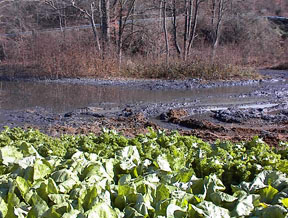A committee of the National Research Council, made up of experts in geology, hydrology, coal mining and engineering, released Coal Waste Impoundments: Risks, Responses, and Alternatives on Oct 12. The report outlined where the United States falls short in terms of coal impoundment safety and environmental responsibility.
 Coal impoundments
hold wastewater and impurities that result from coal washing and processing.
A bulkhead or embankment is made of coarse coal refuse and acts as a dam. Behind
it lies a pond of coal slurry. Sediment settles out of this turbid mixture,
filling the pond, while wastewater is recycled back into the coal washing process.
The sizes of the ponds and bulkheads vary, but pond basins are often hundreds
of feet deep and hold millions of gallons of slurry. As of this year, 713 coal
waste impoundments exist in the United States. Most are in West Virginia, Virginia
and Kentucky.
Coal impoundments
hold wastewater and impurities that result from coal washing and processing.
A bulkhead or embankment is made of coarse coal refuse and acts as a dam. Behind
it lies a pond of coal slurry. Sediment settles out of this turbid mixture,
filling the pond, while wastewater is recycled back into the coal washing process.
The sizes of the ponds and bulkheads vary, but pond basins are often hundreds
of feet deep and hold millions of gallons of slurry. As of this year, 713 coal
waste impoundments exist in the United States. Most are in West Virginia, Virginia
and Kentucky. [Coal slurry escaped into the rivers around Inez, Ken., after a coal impoundment breach. www.appalachianfocus.org/spill10_2000/coal_slurry_spill.htm.]
Where impoundments fail, disaster results.
The most infamous coal impoundment failure occurred in February of 1972. A bulkhead that held back millions of gallons of coal slurry broke, releasing a torrent of the refuse into Buffalo Creek Hollow in Logan County, W.V. One hundred and twenty-five people were killed, more than 1,000 were injured and about 4,000 were left homeless. Virtually all the homes within the hollow were destroyed.
Recent failures in coal impoundment basins in the South compelled Rep. Hal Rogers (R-Ken.) and Rep. Nick Rahall (D-W.V.) to ask the National Academies’ National Research Council to investigate U.S. coal impoundments. The study aimed to “examine engineering practices and standards currently being applied to coal waste impoundments … [and] develop numerous suggestions and recommendations to reduce the potential for similar accidents in the future.”
A 14-person research committee, chaired by Franklin Orr Jr., Dean of the School of Earth Sciences at Stanford University, compiled the report. Currently, the Mine Safety and Health Administration (MSHA) and Office of Surface Mining (OSM) “require that designers of impoundments include all relevant information but do not call out specific guidelines for site evaluation, design, construction, and operation of basins,” Orr says. The committee concluded that the soundness of the slurry basins should be investigated as much as the stability of the embankments.
The report also describes alternatives to coal impoundments. These include injecting the slurry underground, designing power plants to use impure coal and cleaning coal using magnets and electrostatic forces, not water. With less coal slurry and fewer coal impoundments the risk of dangerous impoundment failure is lessened.
On Oct. 11 last year, Big Sandy River in Inez, Ken., ran black with thick coal sludge. Earlier that day, an abandoned mine below the coal impoundment near Inez collapsed, freeing 250 million gallons of refuse slurry from the impoundment pond. It flooded the mineshaft and spilled out into local rivers and streams, overflowing riverbanks and swamping backyards and roads with tar-like black muck.
The Environmental Protection Agency (EPA) calls the aftermath of the Inez impoundment collapse one of the worst environmental disasters in the South. Inez schools and businesses had to close and some Kentucky towns advised residents to boil their water. Nearby communities in West Virginia rerouted their drinking water pipelines to avoid slurry contamination.
The United States holds 25.1 percent of the world’s coal reserves — more than any other country. And because U.S. coal operations are large-scale and mechanized, they are not very selective or “clean.” The impurities left behind, called coal fines, along with their wash water are stored in coal impoundments.
Jann Vendetti

